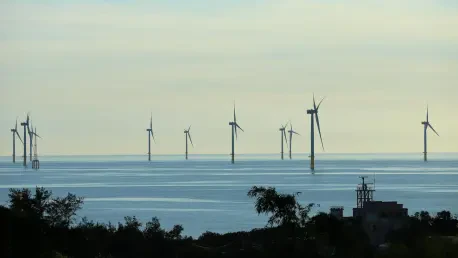In a stunning turn of events, the Trump administration has abruptly halted the Revolution Wind project, a nearly completed offshore wind farm positioned off the coasts of Massachusetts and Rhode Island, raising serious questions about the future of renewable energy in the United States. Spearheaded by the Danish developer Ørsted, this ambitious initiative was poised to deliver 704 megawatts of clean, carbon-free electricity to New England, a region plagued by soaring energy costs during harsh winters. With construction already 80% complete, the sudden issuance of a stop-work order by the Bureau of Ocean Energy Management (BOEM), citing ambiguous “national security interests,” has sent shockwaves through the industry. Stakeholders, including state officials, environmental advocates, and energy experts, are reeling from the decision, which threatens not only the project’s completion but also the broader push for sustainable power in America. This move comes at a critical juncture when the nation is striving to reduce reliance on fossil fuels and combat climate change, making the timing of the halt particularly contentious. The following exploration delves into the intricate details of Revolution Wind, the murky rationale behind the stoppage, the fierce political backlash it has ignited, and the far-reaching economic consequences for both Ørsted and the offshore wind sector at large. As the debate unfolds, the implications of this decision could reshape energy policy and regional priorities for years to come, casting a shadow over the transition to a greener future.
A Closer Look at Revolution Wind’s Vision
The Revolution Wind project stands as a cornerstone of renewable energy ambition in New England, designed to generate a substantial 704 megawatts of power, sufficient to energize countless homes and businesses across the region. Strategically located in a federally designated “wind energy area” south of Martha’s Vineyard and Nantucket, the project emerged from a decade-long planning process that began with Ørsted securing leases through a federal auction over a decade ago. Construction officially started in early 2024, and with 80% of the work already done, its completion was expected to significantly advance the renewable energy goals of states like Rhode Island and Connecticut. These states have set aggressive targets to transition away from fossil fuels, and Revolution Wind was seen as a vital piece of that puzzle, promising not just cleaner air but also more stable energy prices in a region often hit hard by winter price spikes. The project’s scale and strategic importance underscore why its sudden halt has sparked such widespread concern among advocates for sustainable energy solutions.
Beyond its raw power output, Revolution Wind represents a triumph of collaboration and regulatory rigor, having navigated an exhaustive approval process involving diverse stakeholders. Over the years, Ørsted worked closely with local communities, including fishermen, to address potential impacts, while securing endorsements from multiple federal agencies such as the Pentagon and the Federal Aviation Administration. Every aspect, from environmental considerations to turbine lighting standards for aviation safety, was meticulously vetted and approved, ensuring the project met stringent criteria. This painstaking effort made the wind farm a model for how renewable projects can balance community needs with national interests. Thus, the abrupt stoppage, after such extensive groundwork, feels like a betrayal of years of planning and coordination, leaving many to question how a project so thoroughly reviewed could suddenly be deemed a security risk without clear evidence or explanation.
Unpacking the Stop-Work Order’s Rationale
The unexpected stop-work order issued by BOEM, under the leadership of acting director Matthew Giacona, has thrown the Revolution Wind project into a state of uncertainty, with the cited justification of “national security interests” raising more questions than answers. Giacona, whose background includes lobbying for offshore oil and gas interests, announced the halt on a recent Friday, effectively pausing all construction activities without providing detailed reasoning behind the decision. This opacity has frustrated industry experts and state officials alike, especially given that the project had already undergone extensive consultations with military and federal entities over the past decade. The absence of specific information about the alleged security threat has led to widespread speculation about the true motives behind the order, with many wondering if other agendas are at play. The timing and lack of transparency have only deepened the sense of unease surrounding this abrupt intervention.
Compounding the frustration is the fact that this is not an isolated incident under the current administration’s oversight of renewable energy initiatives. Earlier this year, a similar stop-work order was imposed on the Empire Wind project off the coast of New York, resulting in nearly $1 billion in losses for the developer and bringing the project to the brink of cancellation. That precedent casts a long shadow over Revolution Wind, as stakeholders brace for potentially devastating financial and logistical impacts. Without clarity on the duration of the halt or the nature of the supposed security concerns, Ørsted and other involved parties are left in limbo, unable to plan or mitigate damages effectively. This pattern of unexplained interruptions suggests a troubling trend in federal policy toward offshore wind, one that could undermine confidence in the sector’s stability and deter future investments at a time when clean energy is more critical than ever.
Political Backlash and Regional Resistance
The decision to pause Revolution Wind has ignited a firestorm of criticism from political leaders in New England, who view the project as essential to both economic stability and environmental progress. Rhode Island Governor Dan McKee has publicly condemned the stop-work order, arguing that it directly undermines efforts to enhance energy reliability and reduce costs for residents and businesses already struggling with high utility bills. McKee’s stance is echoed by Connecticut Governor Ned Lamont, who labeled the halt a “political move” rather than a decision rooted in genuine security concerns. Both governors have pledged to explore every possible avenue to reverse the order, emphasizing the project’s role in meeting their states’ ambitious clean energy targets. Their unified resistance highlights the deep frustration with federal overreach into regional energy priorities, setting the stage for a contentious battle over the wind farm’s future.
This political clash is reminiscent of an earlier conflict involving the Empire Wind project, where New York Governor Kathy Hochul faced off against the administration to lift a comparable ban. After weeks of tense negotiations, that project eventually resumed, though not without lingering disputes over alleged concessions tied to natural gas infrastructure. For Revolution Wind, the stakes are equally high, as state leaders argue that the halt jeopardizes not just a single project but the broader vision of a sustainable energy landscape in the Northeast. The governors’ determination to push back reflects a growing tension between state-level renewable energy goals and federal policy decisions, raising questions about how such conflicts might be resolved. As the situation unfolds, the outcome could set a precedent for how future disputes over clean energy projects are handled, with implications far beyond the borders of New England.
Economic Fallout and Industry Challenges
The stop-work order on Revolution Wind has delivered a severe blow to Ørsted, the project’s developer, at a time when the company is already navigating significant financial challenges. Facing mounting costs and unforeseen delays, Ørsted recently initiated a fundraising campaign to secure billions from shareholders to complete Revolution Wind and another permitted initiative, Sunrise Wind. The current halt exacerbates these struggles, with potential losses echoing the staggering $1 billion hit suffered during the Empire Wind stoppage earlier this year. Every day of delay adds to the financial strain, threatening not only the project’s viability but also Ørsted’s ability to maintain investor confidence in an increasingly unpredictable market. The uncertainty surrounding the duration of the stoppage further complicates planning, leaving the company vulnerable to escalating costs and diminished returns on a project that was once seen as a flagship for renewable energy.
The ripple effects of this decision extend well beyond Ørsted, casting a pall over the entire offshore wind industry in the United States, which is already grappling with slow progress and limited operational capacity. Currently, only one utility-scale offshore wind farm, South Fork near Long Island, is fully operational, despite several projects under construction. Halts like the one imposed on Revolution Wind send a discouraging signal to developers and investors, suggesting that even nearly completed projects are not immune to sudden policy shifts. This unpredictability heightens the perceived risk of investing in offshore wind, potentially stalling momentum at a critical moment when clean energy is essential for addressing climate change and reducing dependence on fossil fuels. For regions like New England, where energy costs are among the highest in the nation, such setbacks hinder efforts to provide affordable, sustainable power, amplifying the economic and environmental stakes of the administration’s decision.
Navigating the Path Forward
Reflecting on the broader implications of the Revolution Wind halt, it’s clear that this decision reverberated through multiple layers of policy, economics, and regional aspirations. The project, which promised to be a linchpin in New England’s clean energy transition, found itself ensnared in a web of federal intervention that prioritized vague national security claims over years of collaborative planning. State leaders stood firm in their opposition, decrying the economic and environmental toll, while Ørsted grappled with the financial fallout of an uncertain future. The precedent set by this stoppage, alongside the earlier Empire Wind disruption, painted a picture of an administration willing to sideline renewable progress, possibly in favor of competing energy interests. The offshore wind sector, still in its infancy in the U.S., absorbed a harsh lesson about the fragility of policy support in the face of shifting political winds.
Looking ahead, the resolution of this conflict demanded innovative strategies and persistent advocacy from all stakeholders involved. State governments in Rhode Island and Connecticut needed to leverage legal and diplomatic channels to challenge the stop-work order, while Ørsted had to secure alternative funding mechanisms to weather the delay. On a national level, clearer guidelines around national security assessments for energy projects could prevent such abrupt halts in the future, fostering a more stable environment for renewable development. Industry leaders and policymakers alike should prioritize dialogue to balance security concerns with the urgent need for clean energy, ensuring that projects like Revolution Wind aren’t derailed without transparent justification. As the push for a sustainable energy future continued, the lessons from this episode underscored the importance of resilience and adaptability in overcoming systemic barriers to progress.









